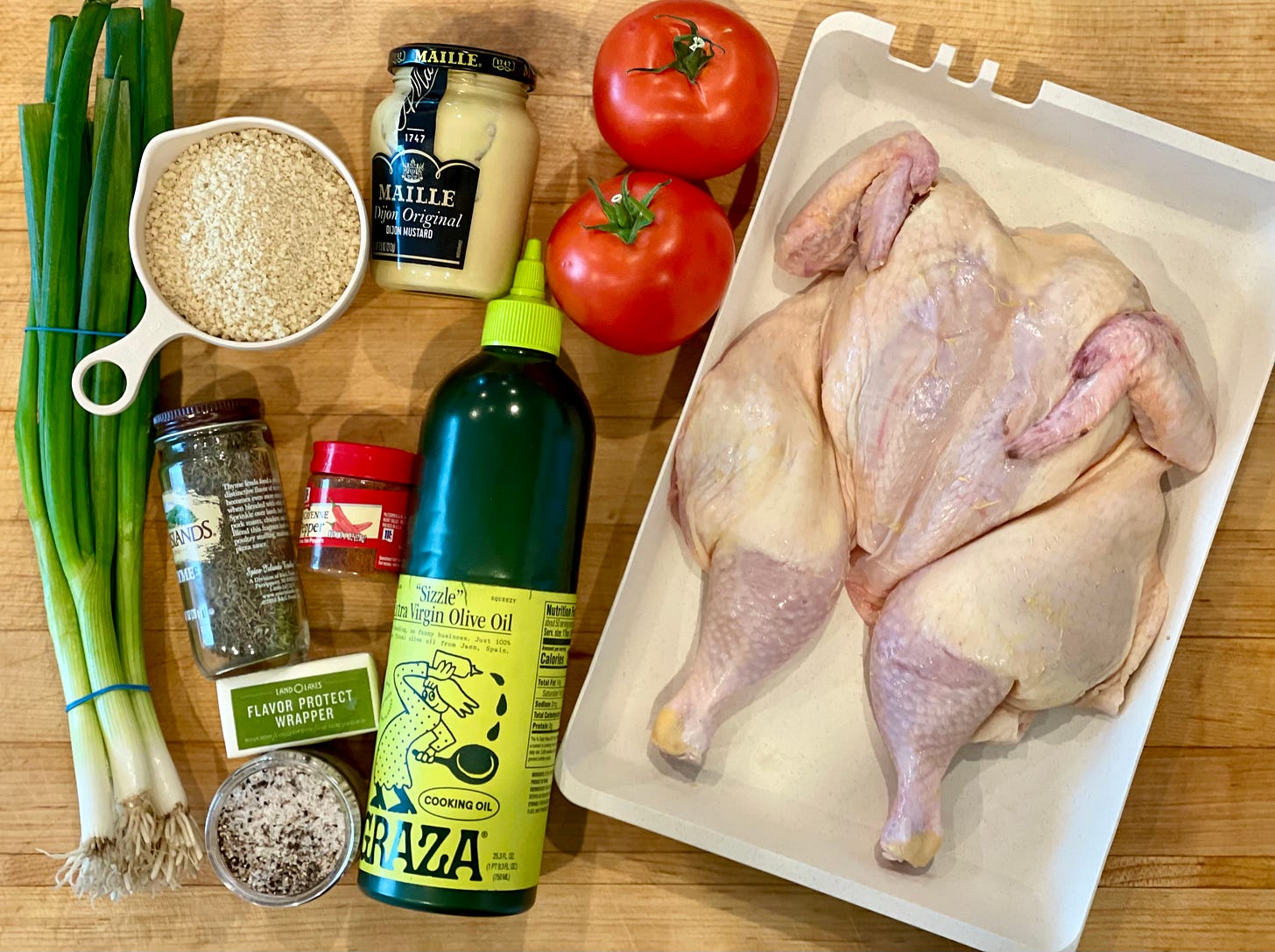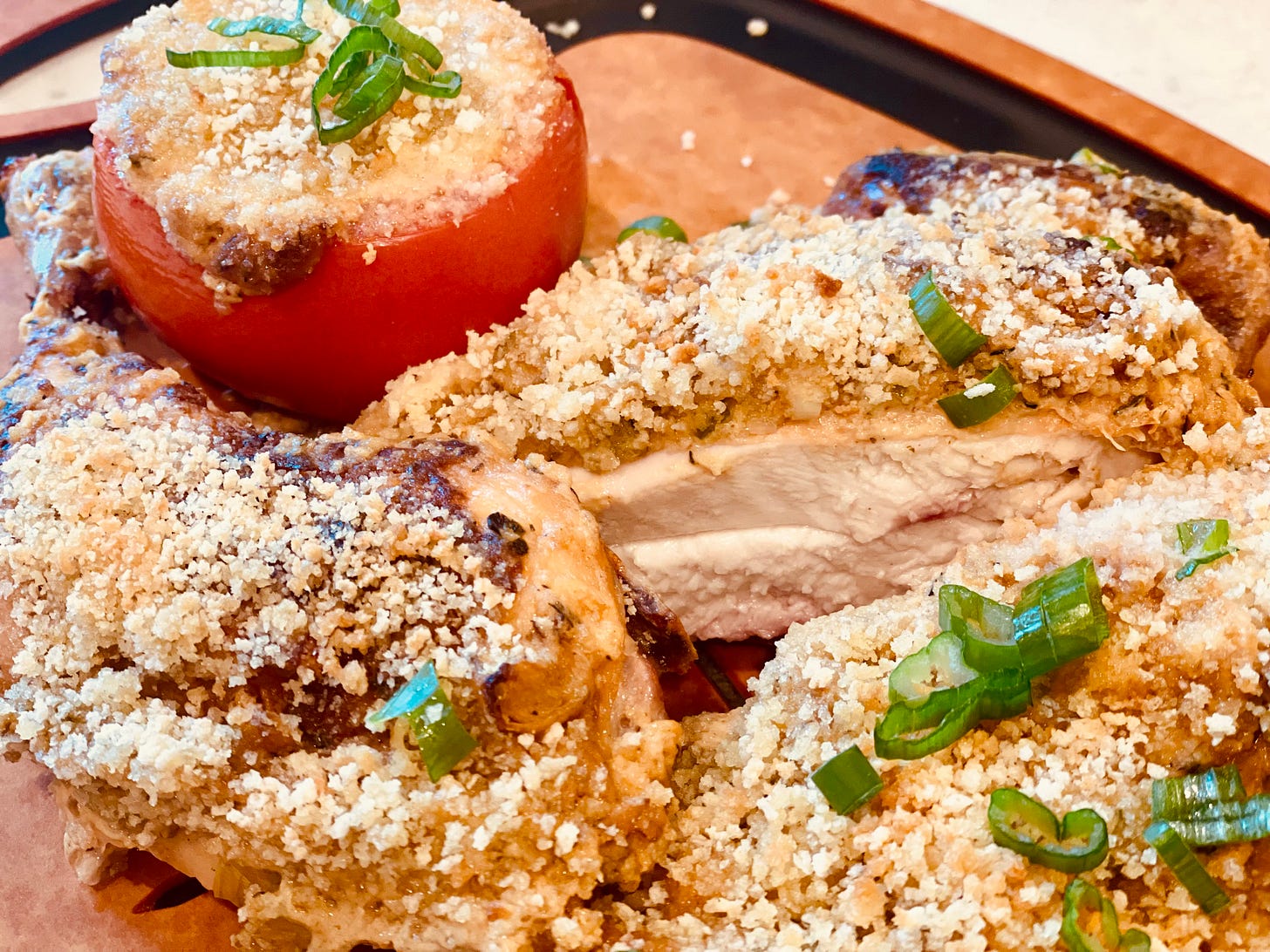What Would Julia Do? She'd Make a (French) Chicken.
Happy Thursday W4D friends! Do you ever long for a trip to France without leaving your kitchen? Well, you’re in luck, because this week’s recipe is inspired by the patron saint of French food in America, Julia Child.
FRENCH CHICKEN SLATHERED WITH DIJON MUSTARD AND SCALLIONS

EK: Did you watch Julia on (HBO)Max? If you love all things culinary and have not yet, you should! Helen Rosner writes a compelling summary of the series in The New Yorker, and if that doesn’t convince you, maybe my version of “French Chicken” will.
AU: I absolutely LOVED the series, Julia, and it inspires me to get in the kitchen and be fearless, like she was. When I produced food segments on Good Morning America, I always felt like Julia Child was watching over me, since she was a contributor to the show. Then, when I worked on The Chew (RIP), we were really blessed, because we shot in the same studio in which Julia did most of her Good Morning America cooking segments in the 70s & 80s!
EK: My mother loved Julia Child and cooked as many of her recipes as she did her own mother’s Southern staples. As a result, I was destined to become a Francophile (Paris is still my favorite city, by far). Needless to say, I am also a big Julia Child fan.
That means that I own most of her books, have seen the Julia movies and TV series, and I’ve read many of the biographies and memoirs written by people who lived with and worked with her—my favorite is by her grand-nephew, Alex Prud’homme.
Alex is the grandson of Julia's husband Paul Child's twin brother Charles—or simply, her grandnephew. He was writing a memoir with his great aunt—Julia—at the time of her death. He finished it and it was published with them both as co-authors. The book, “My Life in France”- Julia Child's memoir of Paris and Provence in the late 1940s and early '50s, is well know among Julia’s followers. Ten years later, he followed that book up with The French Chef in America: Julia Child’s Second Act and if you share my love of Julia they are both well worth reading!
EK: But I digress—back to the food!
My favorite Julia-Child-inspired childhood menu was anchored by what we referred to as “French Chicken,” a butterflied chicken slathered with a sauce of Dijon mustard, white wine and scallions that bakes on the chicken as it roasts, becoming a delectable crust and infusing the chicken with the heady flavors of winey Dijon mustard.
AU: I love these ingredients, and without really knowing it, I subconsciously translated this technique into my favorite pork chops!
EK: Julia’s menus were simple: a main course, a vegetable, and a dessert. This chicken recipe appeared as part of the following menu:
Poulet grille a la diable (“French Chicken”)
Pois frais en braisage (fresh peas braised with lettuce and scallions)
Tarte aux pommes (apple tart)
With the chicken, she suggested fresh peas cooked with butter, Boston lettuce, and more scallions, and dessert was her delicious apple tart with a layer of Grand Marnier-spiked applesauce and a layer of apricot-glazed apple slices on top.
If you’ve been reading W4D for a while, it will be no surprise that I took my favorite childhood chicken dish and adapted it to the grill. The grill facilitates the browning and crisping of the skin with a mustard glaze—making this one chicken that you’ll want to eat skin and all!
It may not be exactly as Julia intended, but it certainly brings her spirit into my home every time I make it, and I hope this dish will bring her into your home as well!

EK: I’ve streamlined her recipe to make it as easy as possible. Basically, you grill-roast a spatchcocked (same as butterflied) chicken until it is almost done, then you slather it with the mustard sauce, and let that cook until it is set. Then you add crunchy panko breadcrumbs and continue cooking until they are lightly browned. Let it rest for 10 minutes and serve the chicken!
Check out this step-by-step tutorial in spatchcocking your own chicken (scroll down to the second recipe in the link).

EK: The chicken is coated with EVOO and seasoned with salt and pepper, just like most Grilling 101 recipes. If you don’t feel like grilling, you could roast in a preheated 350°F oven. Place the chicken on a rack set into a sheet pan, and roast for about 30 minutes before adding the mustard sauce.
You want to make sure that the internal temperature is about 140°F in the breast and 160°F in the thigh (it will finish cooking once you add the sauce and the panko bread crumbs). The final temperature should be 160-165°F in the breast and 180°F in the thickest part of the thigh.
AU: We’ve said it before, but it bears repeating, cooking a spatchcocked (“butterflied”) chicken is not only easier, it cooks faster, too! I also love that there’s more surface area to get crispy. I want to reiterate Elizabeth’s point about the two different temperatures—if the temp in the thigh is 165ºF, it’s safe to eat, but it will be a heck of a lot tastier—and a more pleasing texture—if you cook it to 178-180ºF.
EK: Thanks for that clarification, A! It sounds confusing that you need to reach 2 separate end temps for one bird, but the dark meat is more tender and tastes better when cooked longer!
For a side dish, you could make peas and butter and throw in a couple of Boston lettuce leaves and scallions like Julia did, or make ‘broiled tomatoes.’ Broiled tomatoes are old fashioned, but I love them with this chicken. Plus, they really brighten up a very brown plate!
When you make the chicken, reserve some of the mustard sauce, and spread it on top of tomatoes that have the top sliced off. Add panko breadcrumbs, and grill them on a small sheet pan during the final cooking time until they are bubbling.
As Julia would say, “Bon appétit!”






